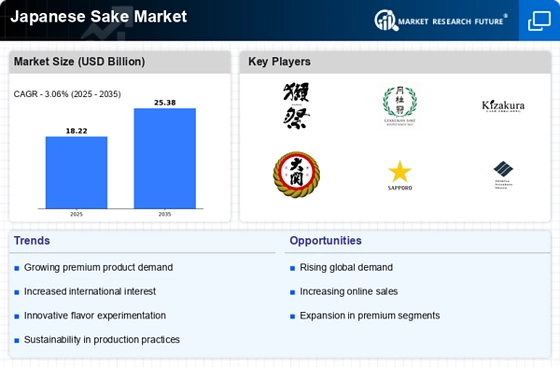Evolving Consumer Preferences
In the Japanese Sake Market, evolving consumer preferences are shaping the landscape of sake consumption. Younger generations are increasingly gravitating towards premium and craft sake, favoring quality over quantity. This shift is reflected in the rising popularity of artisanal breweries that emphasize traditional brewing methods and unique flavor profiles. Market data indicates that sales of premium sake have increased by approximately 15% in recent years, suggesting a significant shift in consumer behavior. Additionally, the trend towards sustainability and organic products is influencing purchasing decisions, as consumers become more conscious of the ingredients and production processes behind their beverages. This evolution in preferences presents both challenges and opportunities for producers to innovate and adapt their offerings to meet the demands of a discerning clientele.
Increasing International Demand
The Japanese Sake Market is experiencing a notable increase in international demand, particularly in regions such as North America and Europe. This trend is driven by a growing interest in Japanese culture and cuisine, which has led to a rise in sake consumption among non-Japanese consumers. According to recent data, exports of sake have surged, with a reported increase of over 20% in the last year alone. This expanding market presents opportunities for producers to diversify their offerings and cater to a broader audience. As more consumers seek authentic experiences, the Japanese Sake Market is likely to benefit from this heightened interest, potentially leading to further growth in export volumes and brand recognition on the global stage.
Growing Interest in Sake Tourism
Sake tourism is emerging as a significant driver for the Japanese Sake Market, attracting both domestic and international visitors to sake breweries and regions known for their sake production. This trend is fueled by the desire for experiential travel, where consumers seek to engage with local cultures and traditions. Data indicates that sake-related tourism has increased by approximately 25% in recent years, with many breweries offering tours, tastings, and educational experiences. This influx of visitors not only boosts local economies but also enhances brand visibility for sake producers. As the interest in sake tourism continues to grow, it is likely to create new opportunities for collaboration between breweries and tourism operators, further promoting the Japanese Sake Market.
Regulatory Support and Promotion
Regulatory support and promotion are vital factors influencing the Japanese Sake Market. The Japanese government has implemented various initiatives to promote sake both domestically and internationally, recognizing its cultural significance and economic potential. Programs aimed at supporting sake producers through subsidies and marketing campaigns have been established, which may enhance the visibility of Japanese sake on the world stage. Additionally, regulations that ensure quality standards help maintain the integrity of the product, fostering consumer trust. Recent data suggests that government initiatives have contributed to a 10% increase in sake exports, indicating the positive impact of regulatory support. As these efforts continue, they are likely to bolster the Japanese Sake Market, encouraging growth and sustainability.
Technological Advancements in Production
Technological advancements are playing a crucial role in the Japanese Sake Market, enhancing production efficiency and quality. Innovations in brewing technology, such as precision fermentation and temperature control, allow producers to create more consistent and high-quality sake. Furthermore, advancements in packaging technology are improving shelf life and presentation, making sake more appealing to consumers. Market analysis suggests that these technological improvements could lead to a reduction in production costs by up to 10%, thereby increasing profitability for producers. As the industry embraces these advancements, it is likely to attract investment and foster a competitive environment, ultimately benefiting the Japanese Sake Market as a whole.















Leave a Comment